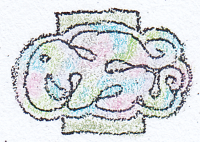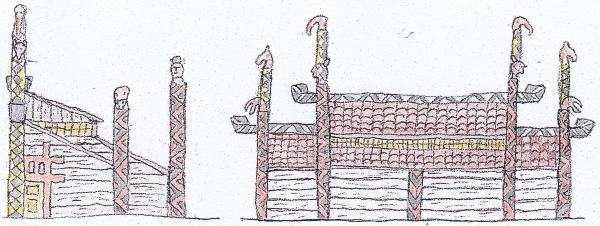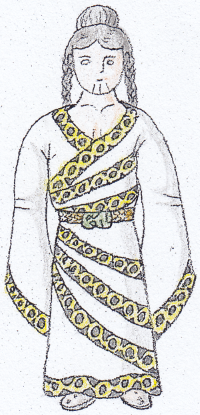Sanxeans
Sanxean: Sanxop
Barp: Sanxóm
Afnat: Akn Tei-reiga Hefmólic: Zanxúxok
The sanxeans1 are the ruling ethnic group in the kingdom of Sanx in western Emlas, the oldest civilization in the region. Though not quite as interested in conquest as the other major powers of Gætíus' World, sanxean customs and religious traditions have influenced those of their neighbouring cultures, either directly as is the case with the Paróbaxi, or indirectly as with the more distant Bemlans.
While their knowledge of the eastern emlatine civilizations is generally limited, sanxean goods are highly sought after by the latter and vice versa.
Jewelry is made from gold, jade, mother-of-pearl, shells and pearl, often featuring stylized animal imagery.
Head-flattening is practiced by the aristocracy to distinguish them from commoners. Jade and mother-of-pearl signet ring
Shamans oversee all major rituals to make sure everything is done correctly, and also use various methods to see into people's future for a price.
Barp: Sanxóm
Afnat: Akn Tei-reiga Hefmólic: Zanxúxok
The sanxeans1 are the ruling ethnic group in the kingdom of Sanx in western Emlas, the oldest civilization in the region. Though not quite as interested in conquest as the other major powers of Gætíus' World, sanxean customs and religious traditions have influenced those of their neighbouring cultures, either directly as is the case with the Paróbaxi, or indirectly as with the more distant Bemlans.
While their knowledge of the eastern emlatine civilizations is generally limited, sanxean goods are highly sought after by the latter and vice versa.
Society
Sanxean society is divided into an aristocracy -royalty and important families-, commoners and slaves, the latter which are war captives or their descendants.Culture
Apparel
Sanxean clothes vary between regions and classes, with commoners wearing mostly loincloths or simple cloaks, while the wealthy often wear a kind of open tunic with one lapel wrapped around the body and kept in place with a belt, along with wide, elaborately embroidered cloaks. Both are often made from the hairs of sanxean wool dogs2, while cedar bark cloth is more popular in the coastal regions to the west. Bear- or otterskin cloaks are also worn by monarchs and shamans.Jewelry is made from gold, jade, mother-of-pearl, shells and pearl, often featuring stylized animal imagery.
Head-flattening is practiced by the aristocracy to distinguish them from commoners. Jade and mother-of-pearl signet ring
Art
Architecture
Like in many cultures in western Emlas, sanxean families live in longhouses, from simple structures with straw roofs and wicker walls to elaborately painted ones with carved figures of deities and family totems. The latter are often built on low platforms of rammed earth and walled off by a palisade. A wealthy family's longhouseCuisine
Sanxean diet is varies somewhat between regions, with acorns and millet being the staple food to the southeast, water oats, salmon and other fish to the north and seafood along the coast, along with berries, various vegetables, pork, wild game and fish oil. Tea is the main beverage, of which there are a number of different varieties.Language
Sanxeans write using a system of glyphs, each representing a particular word or concepts, some symbols are stylized images of the things they represent, while others are more abstract. The script evolved from symbols used by shamans and chiefs long ago, and was standardized and expanded early in Sanx's history, but has since slowly diverged into regional -though still mutually intelligible- variants.Religion
The worship of nature spirits, sacred animals, constellations and ancestors is central to sanxean religious life, all of which are honoured through offerings of food, drink, incense, animal and (for major ceremonies) human sacrifice. Members of the aristocracy often partake in ritual dancing and theatrical performances, the latter which are sometimes open to the public and tell stories of the monarch's achievements as well as those of his ancestors, in order to legitimize the dynasty's rule.Shamans oversee all major rituals to make sure everything is done correctly, and also use various methods to see into people's future for a price.







Comments